Review of Bowling For Columbine (Special Edition)
Introduction
On the morning of April 20th, 1999, Eric Harris and Dylan Klebold knocked down a few rounds of pins at their local bowling alley before setting off for their high-school, each of them stocked with home-made explosives and automatic weapons and proceeded to murder their class-mates. When the smoke of gun-fire and pipe-bombs had faded, 12 students and a teacher lay dead and Americans came face to face with the violence threatening to consume an increasingly fragmentary society and the fear and paranoia that was stoking it. It is this event, suggests filmmaker Michael Moore in ‘Bowling For Columbine’, that crystallized everything that was wrong about the self-destructive violence at the heart of American culture: the rampant scapegoating that followed the shootings, distracting the populace from the real genesis of the problem. In casting his net over issues as diverse as an aggressive American foreign policy and a right-wing handling of welfare, Moore develops an exasperating patch-work of influences conspiring to construct this appalling cycle of violence.

Video
Sharp anamorphic transfer, effectively balancing the various film-stocks.

Audio
A clear, effective 5.1 mix, that unsurprisingly doesn’t make much use of the rear channels.
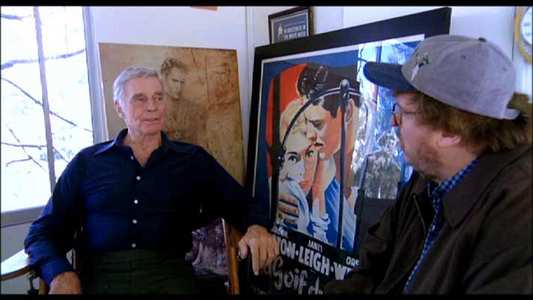
Features
A 2-disc set (released, frustratingly, in a cycle that is becoming routine for Momentum, only months after the original release) that operates as a somewhat ungainly psychological portrait of Moore himself. The tone is somber and generally extremely politicized, lacking even a hint of the humor of the film itself. There’s Michael the rhetorical showman with the heart of a leftist demagogue behind the mask of a stand-up comic in a speech in Denver, Colorado, a year after the release of ‘Bowling For Columbine’. The weird propagandistic flavor of this set persists with a supposedly light-hearted interview with former Clinton press secretary Joe Lockhart, as it’s basically the same spiel thinly-veiled beneath coy laughter and the noisy approval of his liberal supporters.
An interview on ‘The Charlie Rose Show’ offers the only glimpse of a challenge to Moore’s position, but the white-wash continues in an intriguing home video, featuring Moore reciting his Oscar speech, and discussing what really happened under the glare of the Academy’s spotlights and the world’s media as he went to collect his award and berate the Bush administration. At times, Moore doesn’t even seem to believe his own words (he has a particularly hard time explaining why his supporters would begin booing those heckling him), and his pleas for people to appreciate the honest authenticity of his existence makes his personality more clear: there is something child-like about the meekness of his conviction, the affectedness of his apparent modesty, gentle but chiding, our ever supportive conscience. Somewhat more carefree is the yak-track, but, in lieu of a proper commentary we get a handful of air-headed interns sniggering for two hours. Finally, there’s a rousing music video promoting new best buddy Marilyn Manson; the promo for ‘Fight Song’ is featured briefly in the movie, and provides a powerful, anarchic corollary to Moore’s philosophy here. A brief introduction to the film, as well as the theatrical trailer and a photo gallery round off an interesting set, missing only a look at what must have been vast amounts of unused footage.
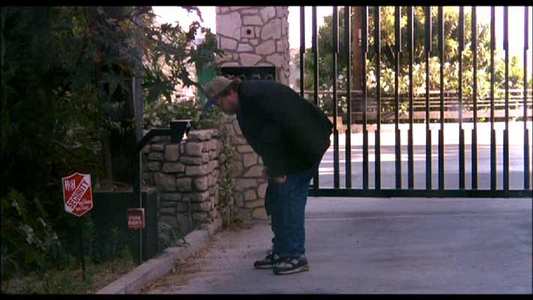
Conclusion
As with his memorable 1989 documentary ‘Roger and Me’, Moore crafts a fascinating, engaging film from an unconventional, sprawling narrative structure. Hilarious passages (an animated American history segue, for example) manage to sit seamlessly with horrifying CCTV images of the Columbine shootings. At times, the comedy can be as strident as Moore’s flailing rhetoric, but what holds the attention is editor Kurt Engfehr’s biting comedy-dialectic. Satirical images snap against one another like the jaws of a jackal, holding the savage tone changes on their binding course of didactic righteousness. A sprightly pace allows the film to flit past unconvincing, superficially posited claims to more persuasive assertions. However, every movie needs a villain, and Moore has Moses himself, Charlton Heston, raging with guttural conviction on the podium of the NRA, leading to the tumultuous showdown that concludes the film.
As the film tries to toil towards a conclusion, Moore’s tone becomes more melancholy, his arguments more specious, his dichotomy from Heston more artificially postulated: he places a warm arm around a grieving interviewee as Heston heckles his eternal refrain from beyond like a demonic specter of conservative unflappability. His seemingly incessant pioneer chorus: “From my cold, dead hands,” is wrenched from the satire to make an absurdly manipulative connection to an untenable grief resulting from fire-arms violence. There are many such moments, and as ‘Bowling For Columbine’ wraps us up in its probing, passionate treatise, one begins to see Moore not as a crusader for the truth, but as an evangelist for his own moral vanity.
Moore is notorious for fashioning facts for his own ideological ends, and ‘Bowling For Columbine’ is no exception, leading to a conclusion of startling superficiality and liberal narcissism. In a final set-piece of moral grandstanding, staged like a Dionysian denouement, Moore confronts Heston at his modernist enclave and engages in a tense verbal tussle. Heston, despite his physical frailties, is polite and earnest whilst his adversary quivers in fevered anger. The whole depressing scenario ends with a final exploitative contrivance: Moore places the photograph of a young girl, shot dead by her six year old class-mate, on Heston’s door-step when he flees the interrogation. It’s a jolting moment, firstly, for the rational incoherence of the association: in the rest of the film, Moore chiefly blames an inadequate social welfare policy and the tabloid fear-mongering of American television for the gun control problem, so surely Heston is less a child-killing ogre and more a tangential figure of a far wider problem? But more problematically, Moore shoots the sequence in movie-ish two-shot, cutting between himself holding the dead child’s photograph to Heston sauntering apathetically away. The truth of Moore’s process becomes clear: he’s been able to create a fervently compulsive documentary due to his reliance on the dramatic affectations of the fiction film. ‘Bowling For Columbine’ is a provocative, passionate, frequently convincing filmic essay, but make no mistake, this is as emotionally manipulative as the conservative media complex Moore claims to oppose.
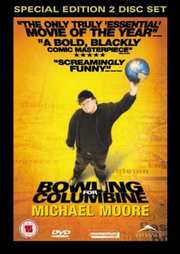





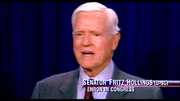

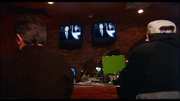


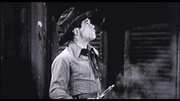




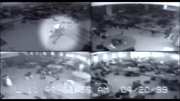






































Your Opinions and Comments
Be the first to post a comment!